Coupling Water Resources and Agricultural Practices for Sorghum in a Semiarid Environment
Abstract
1. Introduction
2. Materials and Methods
2.1. Experimental Site
2.2. Agronomic Characteristics of the Sorghum Cultivar
2.3. Treatments and Experimental Design
2.4. Preparing the Area and Planting the Sorghum
2.5. Irrigation and Agricultural Management System
2.6. Biometric, Biomass, and Physiological Index Analyses
2.7. Soil Salinity and Groundwater Assessment and Determination of Soil Total Organic Matter
2.8. Statistical Analysis
3. Results
3.1. Rainfall and Irrigation Depths during Sorghum Cultivation
3.2. Growth and Sorghum Production under Different Water Regimes Using Wastewater
3.3. Effects of Wastewater Irrigation Depths and Mulch on the Soil Electrical Conductivity and Organic Matter
3.4. Water Table Levels and Salinity Dynamics at the Experimental Area
3.5. Soil Electrical Conductivity (EC) and Total Organic Carbon (TOC) Effects on Sorghum Productivity
4. Discussion
4.1. Rainfall and Irrigation Depths during Sorghum Cultivation
4.2. Growth and Sorghum Production under Different Water Regimes with Wastewater
4.3. Effects of Irrigation Depths with Wastewater and Mulch on Soil Electrical Conductivity and Organic Matter
4.4. Water Table Level and Salinity Dynamics in the Experimental Area
4.5. Impacts of Soil Electrical Conductivity (EC) and of Total Organic Carbon (TOC) on Sorghum Productivity
5. Conclusions
Author Contributions
Funding
Institutional Review Board Statement
Informed Consent Statement
Data Availability Statement
Acknowledgments
Conflicts of Interest
References
- Da Silva, L.C.; Da Silva, J.L.B.; Moura, G.B.D.A.; Silva, D.A.D.O.; Lopes, P.M.O.; Nascimento, C.R.; Da Silva, M.V.; Batista, P.H.D. Índices biofísicos e o saldo de radiação à superfície via sensoriamento remoto no semiárido pernambucano. J. Environ. Anal. Prog. 2021, 6, 12–23. [Google Scholar] [CrossRef]
- Montenegro, A.; Almeida, T.; Lima, C.; Abrantes, J.; de Lima, J. Evaluating mulch cover with coir dust and cover crop with Palma cactus as soil and water conservation techniques for semiarid environments: Laboratory soil flume study under simulated rainfall. Hydrology 2020, 7, 61. [Google Scholar] [CrossRef]
- De Carvalho, A.A.; Montenegro, A.A.D.A.; Da Silva, H.P.; Lopes, I.; De Morais, J.E.F.; Da Silva, T.G.F. Trends of rainfall and temperature in Northeast Brazil. Rev. Bras. Eng. Agrícola Ambient. 2020, 24, 15–23. [Google Scholar] [CrossRef]
- Montenegro, S.G.; Montenegro, A.; Ragab, R. Improving agricultural water management in the semi-arid region of Brazil: Experimental and modelling study. Irrig. Sci. 2009, 28, 301–316. [Google Scholar] [CrossRef]
- Lopes, I.; Montenegro, A.A.A.; de Lima, J.L.M.P. Performance of conservation techniques for semiarid environments: Field observations with Caatinga, mulch, and cactus forage palma. Water 2019, 11, 792. [Google Scholar] [CrossRef]
- Velasco-Muñoz, J.F.; Aznar-Sánchez, J.A.; Batlles-Delafuente, A.; Fidelibus, M.D. Rainwater harvesting for agricultural irrigation: An analysis of global research. Water 2019, 11, 1320. [Google Scholar] [CrossRef]
- Zhang, Y.; Li, X.; Šimůnek, J.; Shi, H.; Chen, N.; Hu, Q.; Tian, T. Evaluating soil salt dynamics in a field drip-irrigated with brackish water and leached with freshwater during different crop growth stages. Agric. Water Manag. 2020, 244, 106601. [Google Scholar] [CrossRef]
- Chaganti, V.N.; Ganjegunte, G.; Niu, G.; Ulery, A.; Flynn, R.; Enciso, J.; Meki, M.N.; Kiniry, J.R. Effects of treated urban wastewater irrigation on bioenergy sorghum and soil quality. Agric. Water Manag. 2019, 228, 105894. [Google Scholar] [CrossRef]
- Valente, S.R.D.P. Direito e políticas públicas: Uma visão jurídico-institucional sobre o caso do saneamento básico no Brasil. REI Rev. Estud. Inst. 2019, 5, 1064–1092. [Google Scholar] [CrossRef]
- da Silva, L.P.B.; Hussein, H. Production of scale in regional hydropolitics: An analysis of La Plata River Basin and the Guarani aquifer system in South America. Geoforum 2019, 99, 42–53. [Google Scholar] [CrossRef]
- Adhikari, P.; Shukla, M.K.; Mexal, J.G. Spatial variability of electrical conductivity of desert soil irrigated with treated wastewater: Implications for irrigation management. Appl. Environ. Soil Sci. 2011, 2011, 1–11. [Google Scholar] [CrossRef][Green Version]
- Flörke, M.; Schneider, C.; McDonald, R.I. Water competition between cities and agriculture driven by climate change and urban growth. Nat. Sustain. 2018, 1, 51–58. [Google Scholar] [CrossRef]
- Libutti, A.; Gatta, G.; Gagliardi, A.; Vergine, P.; Pollice, A.; Beneduce, L.; Disciglio, G.; Tarantino, E. Agro-industrial wastewater reuse for irrigation of a vegetable crop succession under Mediterranean conditions. Agric. Water Manag. 2018, 196, 1–14. [Google Scholar] [CrossRef]
- Carvalho, A.A.; Montenegro, A.A.D.A.; Tabosa, J.N.; Almeida, T.A.B.; Da Silva, A.G.O.; Silveira, A.V.M. Reuso hidroagrícola: Uma solução para convivência com a escassez hídrica no Sertão e Agreste pernambucano. J. Environ. Anal. Prog. 2020, 5, 140–150. [Google Scholar] [CrossRef]
- Feder, F. Irrigation with treated wastewater in humid regions: Effects on Nitisols, sugarcane yield and quality. Agric. Water Manag. 2021, 247, 106733. [Google Scholar] [CrossRef]
- de Lemos, M.; Ferreira-Neto, M.; Fernandes, C.D.S.; de Lima, Y.B.; Dias, N.D.S.; de Medeiros, J.F.; de Brito, R.F.; Sá, F.V.D.S. The effect of domestic sewage effluent and planting density on growth and yield of prickly pear cactus in the semiarid region of Brazil. J. Arid. Environ. 2020, 185, 104372. [Google Scholar] [CrossRef]
- Ungureanu, N.; Vlăduț, V.; Voicu, G. Water scarcity and wastewater reuse in crop irrigation. Sustainability 2020, 12, 9055. [Google Scholar] [CrossRef]
- Schwaller, C.; Keller, Y.; Helmreich, B.; Drewes, J.E. Estimating the agricultural irrigation demand for planning of non-potable water reuse projects. Agric. Water Manag. 2020, 244, 106529. [Google Scholar] [CrossRef]
- Dias, N.S.; Blanco, F.F.; Souza, E.R.; Ferreira, J.F.S.; Souza Neto, O.N. Efeitos Dos Sais Na Planta e Tolerância Das Culturas à Salinidade. Manejo Da Salinidade Na Agricultura: Estudos Básicos e Aplicados, 2nd ed.; INCTSal: Fortaleza, Brazil, 2016. [Google Scholar]
- Elgallal, M.; Fletcher, L.; Evans, B. Assessment of potential risks associated with chemicals in wastewater used for irrigation in arid and semiarid zones: A review. Agric. Water Manag. 2016, 177, 419–431. [Google Scholar] [CrossRef]
- Nagaz, K.; Masmoudi, M.M.; Ben Mechlia, N. Impacts of irrigation regimes with saline water on carrot productivity and soil salinity. J. Saudi Soc. Agric. Sci. 2012, 11, 19–27. [Google Scholar] [CrossRef]
- Abd-Elwahed, M.S. Influence of long-term wastewater irrigation on soil quality and its spatial distribution. Ann. Agric. Sci. 2018, 63, 191–199. [Google Scholar] [CrossRef]
- Yang, T.; Šimůnek, J.; Mo, M.; Mccullough-Sanden, B.; Shahrokhnia, H.; Cherchian, S.; Wu, L. Assessing salinity leaching efficiency in three soils by the HYDRUS-1D and -2D simulations. Soil Tillage Res. 2019, 194. [Google Scholar] [CrossRef]
- Lopez, J.R.; Winter, J.M.; Elliott, J.; Ruane, A.C.; Porter, C.; Hoogenboom, G. Integrating growth stage deficit irrigation into a process-based crop model. Agric. For. Meteorol. 2017, 243, 84–92. [Google Scholar] [CrossRef]
- Oliveira, V.P.; Marques, E.C.; Lacerda, C.F.; Prisco, J.T.; Gomes-Filho, E. Physiological and biochemical characteristics of sorghum bicolor and sorghum Sudanese subjected to salt stress in two stages of development. Afr. J. Agric. Res. 2013, 8, 660–670. [Google Scholar] [CrossRef]
- Jardim, A.M.D.R.F.; da Silva, T.G.F.; de Souza, L.S.B.; Júnior, G.D.N.A.; Alves, H.K.M.N.; Souza, M.D.S.; de Araújo, G.G.L.; de Moura, M.S.B. Intercropping forage cactus and sorghum in a semi-arid environment improves biological efficiency and competitive ability through interspecific complementarity. J. Arid. Environ. 2021, 188, 104464. [Google Scholar] [CrossRef]
- Karlberg, L.; Rockström, J.; Annandale, J.G.; Steyn, M. Low-cost drip irrigation—A suitable technology for southern Africa? An example with tomatoes using saline irrigation water. Agric. Water Manag. 2007, 89, 59–70. [Google Scholar] [CrossRef]
- Montenegro, A.; Abrantes, J.; de Lima, J.; Singh, V.; Santos, T. Impact of mulching on soil and water dynamics under intermittent simulated rainfall. Catena 2013, 109, 139–149. [Google Scholar] [CrossRef]
- Yang, H.; Liu, H.; Zheng, J.; Huang, Q. Effects of regulated deficit irrigation on yield and water productivity of chili pepper (Capsicum annuum L.) in the arid environment of northwest China. Irrig. Sci. 2017, 36, 61–74. [Google Scholar] [CrossRef]
- De Souza, E.R.; Montenegro, A.A.D.A.; Montenegro, S.M.G.; Matos, J.D.A.D. Temporal stability of soil moisture in irrigated carrot crops in northeast Brazil. Agric. Water Manag. 2011, 99, 26–32. [Google Scholar] [CrossRef]
- Borges, T.K.D.S.; Montenegro, A.A.D.A.; Dos Santos, T.E.M.; Da Silva, D.D.; Junior, V.D.P.E.S. Influência de práticas conservacionistas na umidade do solo e no cultivo do milho (Zea mays L.) em semiárido nordestino. Rev. Bras. Ciênc. Solo 2014, 38, 1862–1873. [Google Scholar] [CrossRef][Green Version]
- Gebru, T.A.; Brhane, G.K.; Gebremedhin, Y.G. Contributions of water harvesting technologies intervention in arid and semi-arid regions of Ethiopia, in ensuring households’ food security, Tigray in focus. J. Arid. Environ. 2020, 185, 104373. [Google Scholar] [CrossRef]
- Dos Santos, S.M.; de Farias, M.M.M. Potential for rainwater harvesting in a dry climate: Assessments in a semiarid region in northeast Brazil. J. Clean. Prod. 2017, 164, 1007–1015. [Google Scholar] [CrossRef]
- Tinôco, I.C.M.; Bezerra, B.G.; Lucio, P.S.; Barbosa, L.M. Characterization of rainfall patterns in the semiarid Brazil. Anuário Inst. Geociências 2018, 41, 397–409. [Google Scholar] [CrossRef]
- Silva, A.; Montenegro, A.; Moura, G.; Silva, J.; Souza, L. Chuva mensal provável para o Agreste de Pernambuco. Rev. Bras. Ciências Agrárias 2013, 8, 287–296. [Google Scholar] [CrossRef][Green Version]
- Monteiro, A.L.N.; Montenegro, A.A.D.A.; Montenegro, S.M.G.; Dos Santos, F.X. Avaliação de lavagem parcial de sais em neossolo flúvico irrigado, utilizando modelagem computacional. Eng. Agrícola 2009, 29, 207–220. [Google Scholar] [CrossRef][Green Version]
- Monteleone, M.; Libutti, A. Salt leaching due to rain in Mediterranean climate: Is it enough? Ital. J. Agron. 2012, 7, 6. [Google Scholar] [CrossRef]
- Mojid, M.A.; Acharjee, T.K. Efficacy of monsoon rainfall in salt leaching through a field soil after wheat cultivation under saline water irrigation. Environ. Control Biol. 2013, 51, 35–39. [Google Scholar] [CrossRef][Green Version]
- Gelaye, K.K.; Zehetner, F.; Loiskandl, W.; Klik, A. Effects of soil texture and groundwater level on leaching of salt from saline fields in Kesem irrigation scheme, Ethiopia. Soil Water Res. 2019, 14, 221–228. [Google Scholar] [CrossRef]
- Alvares, C.A.; Stape, J.L.; Sentelhas, P.C.; Gonçalves, J.L.M.; Sparovek, G. Köppen’s climate classification map for Brazil. Meteorol. Z. 2013, 22, 711–728. [Google Scholar] [CrossRef]
- Santos, H.; Carvalho, W.; Dart, R.; Aglio, M.; Sousa, J.; Peres, J.; Fontana, A.; Martins, A.; De Oliveira, A. O Novo Mapa de Solos Do Brasil—Legenda Atualizada—Escala 1:5.000.000. 2017. Available online: http://www.infoteca.cnptia.embrapa.br/infoteca/handle/doc/920267 (accessed on 20 August 2021).
- Instituto Agronômico de Pernambuco (IPA). Sorgo Sudão: Sudan 4202—Cultivar Tolerante a Salinidade e Com Aptidão Para Feno. 2007. Available online: http://www.infoteca.cnptia.embrapa.br/infoteca/handle/doc/487334 (accessed on 20 August 2021).
- Carvalho, A.A.; Montenegro, A.A.D.A.; Santos, C.S.; Silva, T. Zoneamento agrometeorológico da moringa para o Estado de Pernambuco em condições atuais e projeções futuras. J. Environ. Anal. Prog. 2017, 2, 194–202. [Google Scholar] [CrossRef]
- Qian, X.; Gu, J.; Pan, H.-J.; Zhang, K.-Y.; Sun, W.; Wang, X.-J.; Gao, H. Effects of living mulches on the soil nutrient contents, enzyme activities, and bacterial community diversities of apple orchard soils. Eur. J. Soil Biol. 2015, 70, 23–30. [Google Scholar] [CrossRef]
- Costa, J.P.N.; Medeiros, J.F.; Nunes, R.M.D.A.; Junior, E.G.C.; Lira, J.F.B. Crescimento e produção da primeira rebrota de cultivares de sorgo sob diferentes lâminas de irrigação. Rev. Bras. Milho Sorgo 2017, 16, 449–459. [Google Scholar] [CrossRef]
- Allan, R.; Pereira, L.; Dirk, R.; Smith, M. Crop Evapotranspiration—Guidelines for Computing Crop Water Requirements—FAO Irrigation and Drainage Paper. 1998. Available online: http://www.avwatermaster.org/filingdocs/195/70653/172618e_5xAGWAx8.pdf (accessed on 20 August 2021).
- Empresa Brasileira de Pesquisa Agropecuária (EMBRAPA). Manual de Análises Químicas de Solos, Plantas e Fertilizantes, 1st ed.; Empresa Brasileira de Pesquisa Agropecuária (EMBRAPA): Santa Catarina, Brazil, 1999; ISBN 978-85-7383-430-7. [Google Scholar]
- Padilla, F.; Maas, S.; González-Dugo, M.; Mansilla, F.; Rajan, N.; Gavilán, P.; Domínguez, J. Monitoring regional wheat yield in Southern Spain using the GRAMI model and satellite imagery. Field Crop. Res. 2012, 130, 145–154. [Google Scholar] [CrossRef]
- Yeomans, J.C.; Bremner, J.M. A rapid and precise method for routine determination of organic carbon in soil. Commun. Soil Sci. Plant. Anal. 1988, 19, 1467–1476. [Google Scholar] [CrossRef]
- R Core Team. R: A Language and Environment for Statistical Computing; R Foundation for Statistical Computing: Vienna, Austria, 2018. [Google Scholar]
- Dos Santos, C.S.; Montenegro, A.A.D.A.; Dos Santos, M.A.L.; Pedrosa, E.M.R. Evapotranspiration and crop coefficients of Moringa oleifera under semi-arid conditions in Pernambuco. Rev. Bras. Eng. Agrícola Ambient. 2017, 21, 840–845. [Google Scholar] [CrossRef]
- Marengo, J.A.; Bernasconi, M. Regional differences in aridity/drought conditions over northeast Brazil: Present state and future projections. Clim. Chang. 2014, 129, 103–115. [Google Scholar] [CrossRef]
- De França, M.V.; De Medeiros, R.M.; De Holanda, R.M.; Silva, V.D.P.; Ferraz, J.X.V.; Sobral, D.D.M. Aptidão climática para o cultivo da banana em Caruaru-PE, Brasil. J. Environ. Anal. Prog. 2018, 3, 265–274. [Google Scholar] [CrossRef]
- Pereira, M.L.T.; Soares, M.P.A.; Silva, E.; Montenegro, A.A.D.A.; De Souza, W.M. Variabilidade climática no Agreste de Pernambuco e os desastres decorrentes dos extremos climáticos. J. Environ. Anal. Prog. 2017, 2, 394–402. [Google Scholar] [CrossRef]
- Marengo, J.A.; Alves, L.M.; Alvala, R.C.; Cunha, A.P.M.; Brito, S.; Moraes, O. Climatic characteristics of the 2010–2016 drought in the semiarid northeast Brazil region. An. Acad. Bras. Ciências 2018, 90, 1973–1985. [Google Scholar] [CrossRef]
- Alcântara, P.; Sousa, P.G.R.; Brasil, S.O.S.; Sousa, J.P.F.; Bastos, R.L.G.; Viana, T.V.A. Desempenho agronômico do sorgo em função de lâminas de irrigação e cobertura do solo. Rev. Bras. Agric. Irrig. 2017, 11, 2194. [Google Scholar] [CrossRef][Green Version]
- Abrantes, J.; Prats, S.A.; Keizer, J.J.; de Lima, J.L. Effectiveness of the application of rice straw mulching strips in reducing runoff and soil loss: Laboratory soil flume experiments under simulated rainfall. Soil Tillage Res. 2018, 180, 238–249. [Google Scholar] [CrossRef]
- Schneider, J.R.; Caron, B.O.; Elli, E.F.; Schwerz, F.; Engroff, T.D. Solar radiation use efficiency and gross protein of sorghum forage are modified by the cutting management. Ciência Anim. Bras. 2019, 20. [Google Scholar] [CrossRef]
- Taiz, L.; Zeiger, E.; Møller, I.M.; Murphy, A.; Oliveira, P.L.; Mastroberti, A.A.; Junior, A.M.D.; Santarém, E.R.; Mariath, J.E.; Lima, J.C.; et al. Fisiologia e Desenvolvimento Vegetal, 6th ed.; Artmed: Guelph, ON, Canada, 2016; ISBN 978-85-8271-366-2. [Google Scholar]
- Jardel, H.K.; Adroaldo, D.R.; Marcia, X.P.; Wellington, M.; Rogério, R.T.; Leonita, B.G.; Bruna, D.P.; Ricardo, B.R.; Anderson, C.P.; Marcos, V.L.; et al. Variation of leaf area index of the forage sorghum under different irrigation depths in dynamic of cuts. Afr. J. Agric. Res. 2017, 12, 111–124. [Google Scholar] [CrossRef][Green Version]
- Kuraparthy, V.; Sood, S.; Gill, B.S. Genomic targeting and mapping of tiller inhibition gene (tin3) of wheat using ESTs and synteny with rice. Funct. Integr. Genom. 2007, 8, 33–42. [Google Scholar] [CrossRef] [PubMed]
- Zwirtes, A.L.; Carlesso, R.; Petry, M.T.; Kunz, J.; Reimann, G.K. Desempenho produtivo e retorno econômico da cultura do sorgo submetida à irrigação deficitária. Eng. Agrícola 2015, 35, 676–688. [Google Scholar] [CrossRef]
- Costa, E.; Souza, E.; Junior, G.B.; Filho, J.N.; Souza, J.; Tabosa, J.; Leite, M. Cultivo de sorgo em sistema de vazante com e sem cobertura do solo. Rev. Bras. Milho Sorgo 2015, 14, 182–195. [Google Scholar] [CrossRef]
- Lu, P.; Zhang, Z.; Feng, G.; Huang, M.; Shi, X. Experimental study on the potential use of bundled crop straws as subsurface drainage material in the newly reclaimed coastal land in eastern China. Water 2018, 10, 31. [Google Scholar] [CrossRef]
- Travis, M.J.; Wiel-Shafran, A.; Weisbrod, N.; Adar, E.; Gross, A. Greywater reuse for irrigation: Effect on soil properties. Sci. Total Environ. 2010, 408, 2501–2508. [Google Scholar] [CrossRef] [PubMed]
- Thoumazeau, A.; Bessou, C.; Renevier, M.-S.; Trap, J.; Marichal, R.; Mareschal, L.; Decaëns, T.; Bottinelli, N.; Jaillard, B.; Chevallier, T.; et al. Biofunctool®: A new framework to assess the impact of land management on soil quality. Part A: Concept and validation of the set of indicators. Ecol. Indic. 2018, 97, 100–110. [Google Scholar] [CrossRef]
- Miranda, R.J.A. Lâminas de Irrigação com Água Residuária e Adubação Orgânica na Cultura do Algodão BRS Safira. 2010. Available online: http://dspace.sti.ufcg.edu.br:8080/jspui/handle/riufcg/9781 (accessed on 20 August 2021).
- Shahrokhnia, H.; Wu, L. SALEACH: A new web-based soil salinity leaching model for improved irrigation management. Agric. Water Manag. 2021, 252, 106905. [Google Scholar] [CrossRef]
- TishehZan, P.; Naseri, A.; Hasanoghli, A.; Mesgarbashi, M. Determine the effect of groundwater depth and salinity on its contribution to the water requirement and the growth of palm seedlings with the use of mulch. Iran. J. Soil Water Res. 2017, 48, 533–541. [Google Scholar] [CrossRef]
- Yavuz, D.; Seymen, M.; Süheri, S.; Yavuz, N.; Türkmen, Ö.; Kurtar, E.S. How do rootstocks of citron watermelon (Citrullus lanatus var. citroides) affect the yield and quality of watermelon under deficit irrigation? Agric. Water Manag. 2020, 241. [Google Scholar] [CrossRef]
- Montenegro, A.; Junior, S.; Montenegro, S.M.G.L.; Santos, T.; Paula, V.; Ant, A. Erosão hídrica e perda de carbono orgânico em diferentes tipos de cobertura do solo no semi-árido, em condições de chuva simulada. RBRH 2008, 13, 113–125. [Google Scholar] [CrossRef]
- Urra, J.; Alkorta, I.; Mijangos, I.; Epelde, L.; Garbisu, C. Application of sewage sludge to agricultural soil increases the abundance of antibiotic resistance genes without altering the composition of prokaryotic communities. Sci. Total Environ. 2018, 647, 1410–1420. [Google Scholar] [CrossRef] [PubMed]
- Coelho, D.S.; Simões, W.L.; Mendes, A.M.S.; Dantas, B.F.; Rodrigues, J.A.S.; De Souza, M.A. Germinação e crescimento inicial de variedades de sorgo forrageiro submetidas ao estresse salino. Rev. Bras. Eng. Agrícola Ambient. 2014, 18, 25–30. [Google Scholar] [CrossRef][Green Version]
- Heathman, G.C.; Cosh, M.; Han, E.; Jackson, T.J.; McKee, L.; McAfee, S. Field scale spatiotemporal analysis of surface soil moisture for evaluating point-scale in situ networks. Geoderma 2012, 170, 195–205. [Google Scholar] [CrossRef]
- Jeronimo, C.E.; Silva, G.O. Estudo de alternativas para o aproveitamento de resíduos sólidos da industrialização do coco. Rev. Monogr. Ambient. 2013, 10, 2193–2208. [Google Scholar] [CrossRef][Green Version]
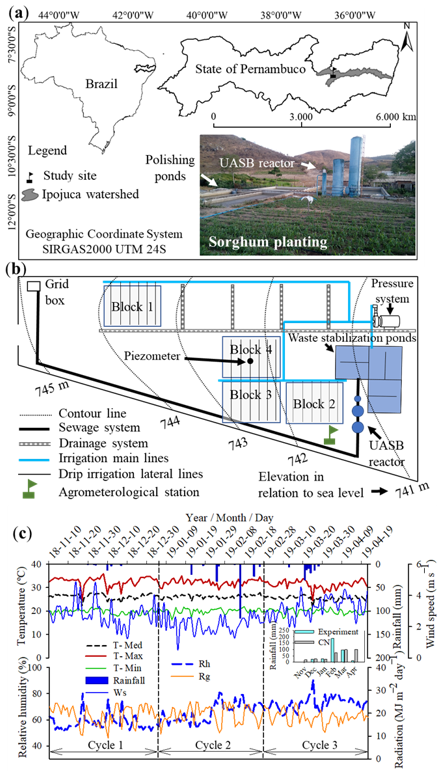

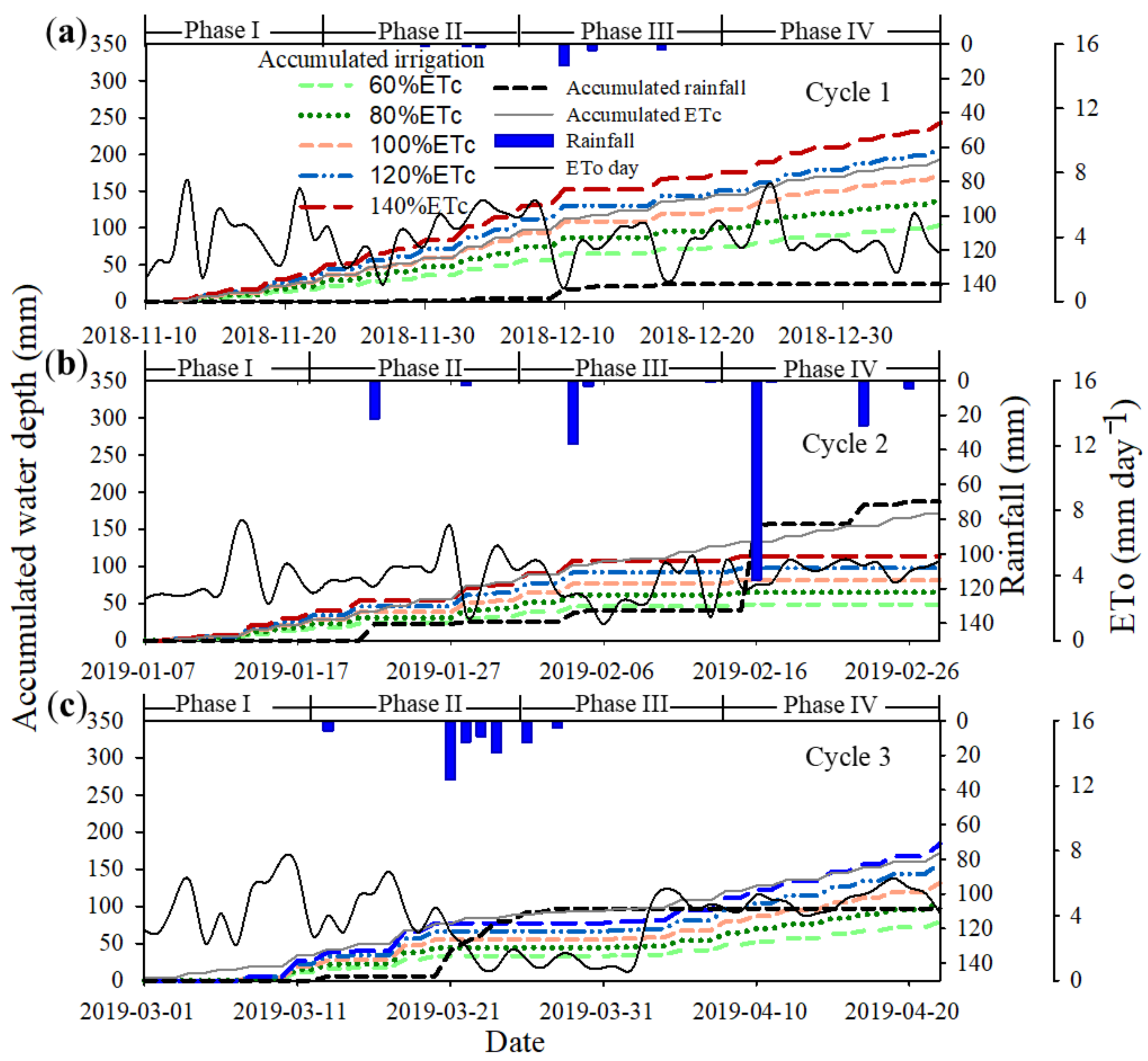

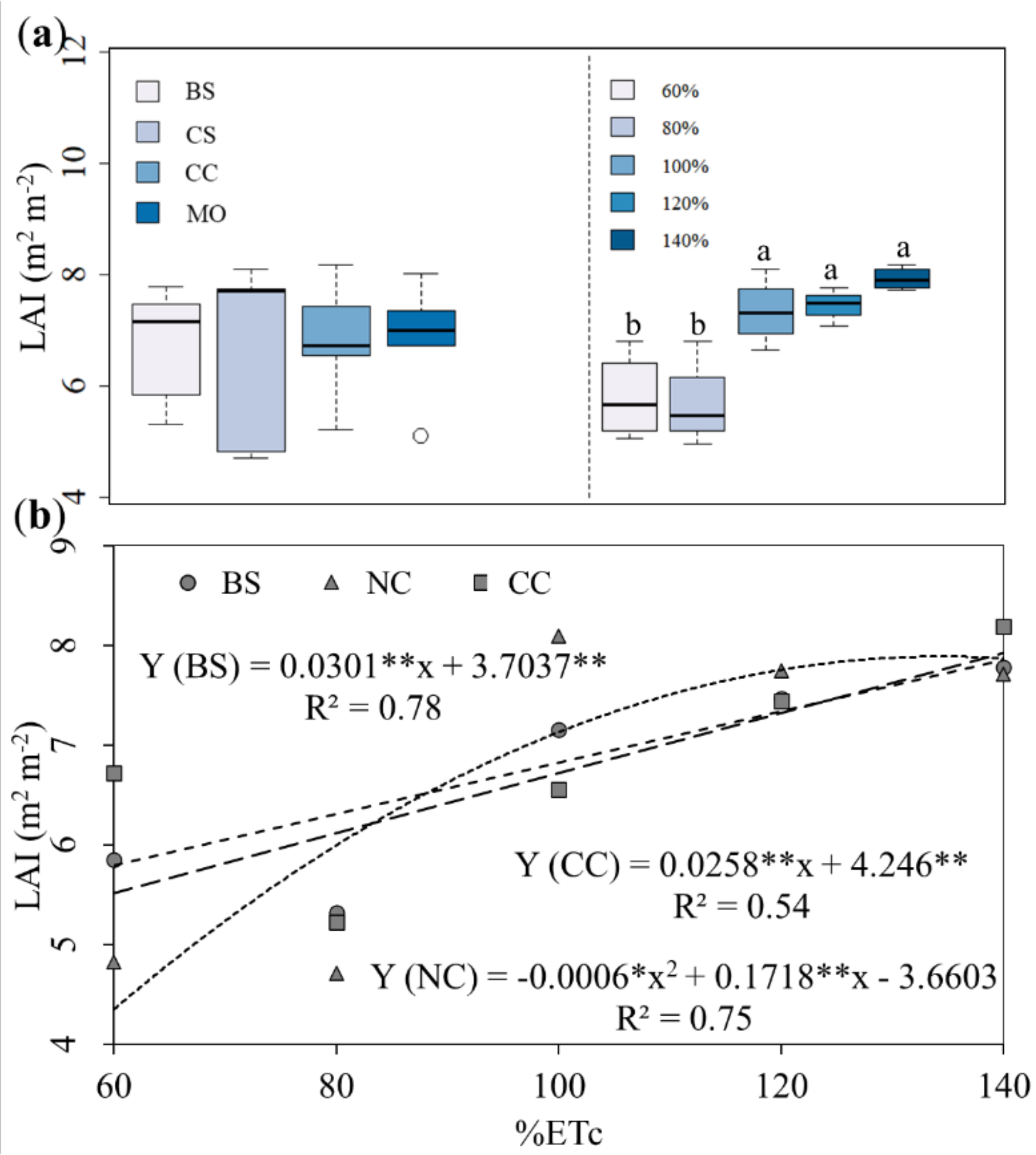

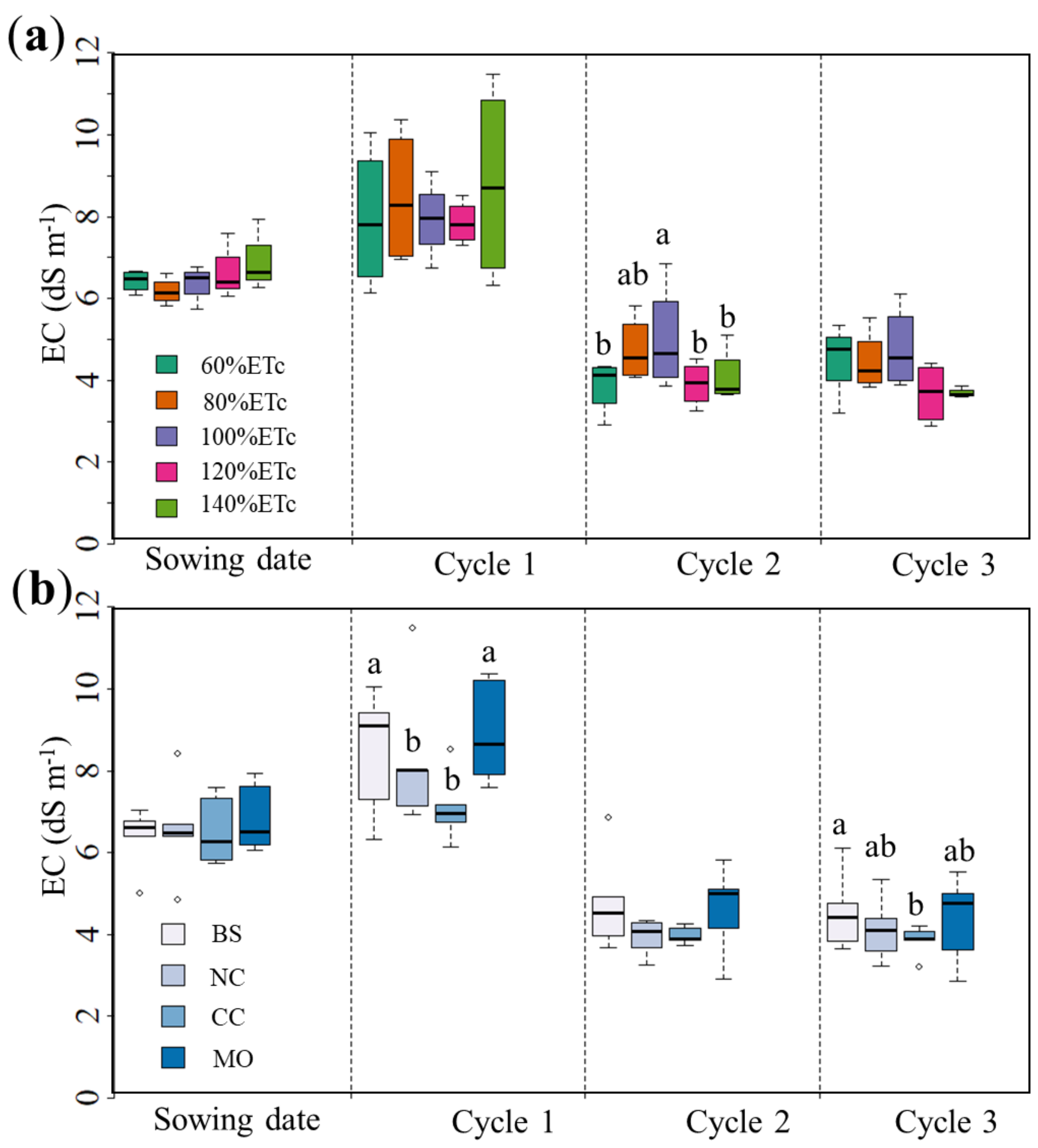
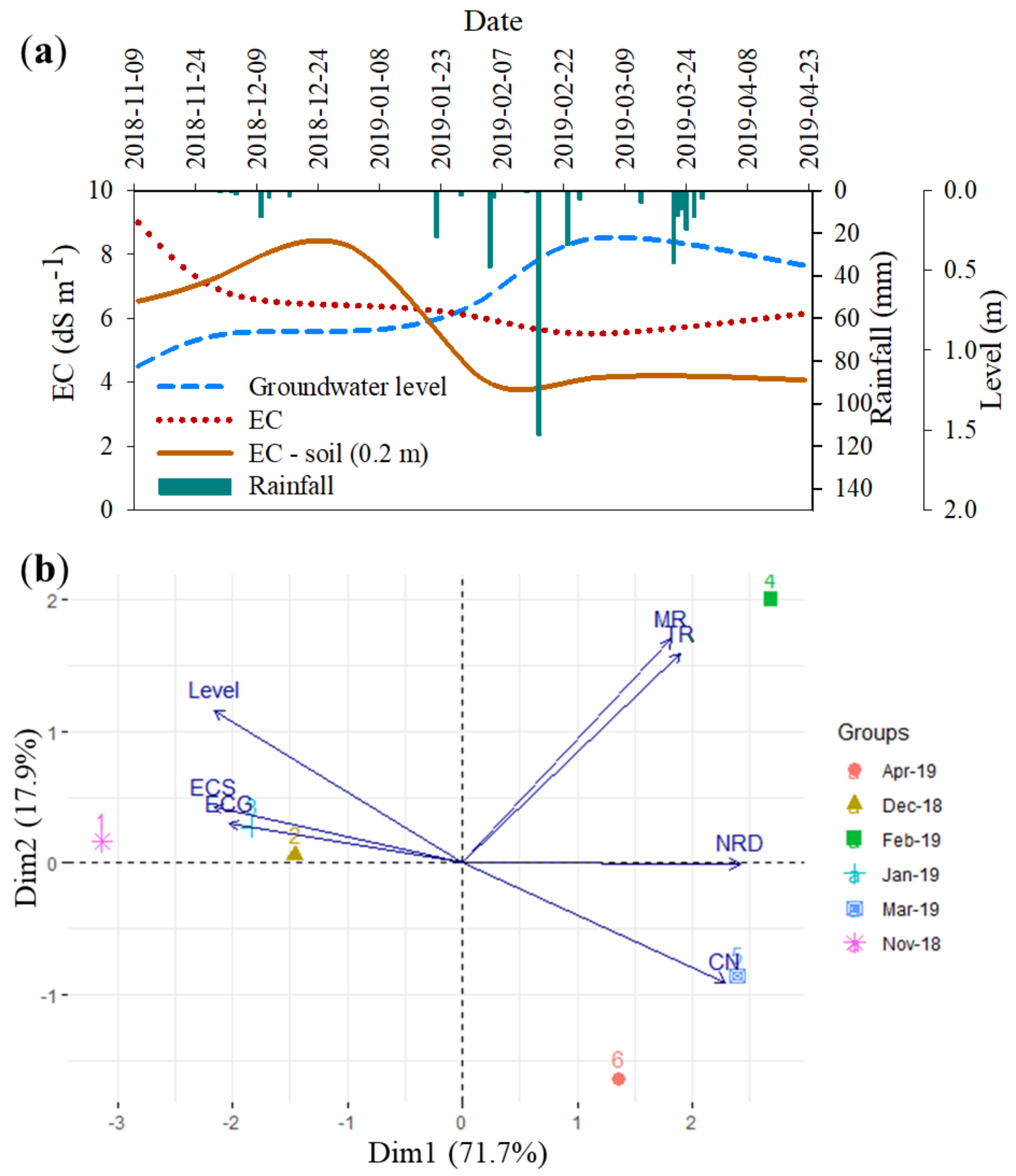


| Soil Physical Characteristics | Layer (0–20 cm) | Layer (20–40 cm) |
|---|---|---|
| Sand (%) | 84.0 | 84.2 |
| Silt (%) | 3.6 | 3.0 |
| Clay (%) | 12.4 | 12.8 |
| Density (g cm−3) | 1.4 | 1.5 |
| Field Capacity (cm³ cm−3) | 0.3 | 0.3 |
| Wilting Point (cm³ cm−3) | 0.2 | 0.2 |
| Saturated paste extract | ||
| pH | 8.0 | 8.2 |
| EC (dS m−1) | 6.9 | 7.2 |
| P (ppm) | 264.0 | 326.0 |
| Na2+ (cmolc dm−3) | 0.4 | 0.9 |
| Ca2+ (cmolc dm−3) | 5.0 | 5.1 |
| Mg2+ (cmolc dm−3) | 0.5 | 1.1 |
| K+ (cmolc dm−3) | 0.8 | 1.0 |
| Aluminum | Not present | Not present |
| Parameter (Unit) | Values |
|---|---|
| pH | 8.3 |
| EC (dS m−1) | 5.7 |
| BOD (mg L−1) | 30.0 |
| QOD (mg L−1) | 125.0 |
| TOC (mg L−1) | 12.1 |
| TDS (mg L−1) | 2869.0 |
| N-Total (mg L−1) | 23.6 |
| P-Total (mg L−1) | 2.0 |
| K+ (mg L−1) | 85.8 |
| Ca2+ (mg L−1) | 34.5 |
| Mg2+ (mg L−1) | 50.9 |
| Na+ (mg L−1) | 782.0 |
| Nitrate (mg L−1) | 42.4 |
| Chloride (mg L−1) | 950.0 |
| Sulfate (mg L−1) | 103.7 |
| Bicarbonate (mg L−1) | 647.2 |
| LAI (m2 m−2) | |||||
|---|---|---|---|---|---|
| ETc (%) | |||||
| Cover Types | 60 | 80 | 100 | 120 | 140 |
| BS | 5.84 ab BC | 5.32 ab C | 7.15 ab AB | 7.47 A | 7.78 A |
| NC | 4.82 b B | 4.7 b B | 8.09 a A | 7.74 A | 7.71 A |
| CC | 6.72 a ABC | 5.22 b C | 6.55 b BC | 7.43 AB | 8.19 A |
| MO | 5.1 b B | 6.71 a A | 7.35 ab A | 7.01 A | 8.03 A |
| Start | |||||
|---|---|---|---|---|---|
| ETc (%) | |||||
| Soil Cover Condition | 60 | 80 | 100 | 120 | 140 |
| BS | 6.60 | 6.60 | 6.78 | 6.41 | 6.62 |
| NC | 6.10 | 6.10 | 6.48 | 6.41 | 6.68 |
| CC | 6.36 | 5.83 | 5.73 | 6.59 | 6.28 |
| MO | 6.67 | 6.19 | 6.52 | 6.05 | 6.94 |
| Cycle 1 | |||||
| BS | 10.38 a A | 9.70 ab AB | 9.33 AB | 7.41 BC | 6.33 b C |
| NC | 6.99 b A | 7.24 b B | 8.18 B | 8.17 B | 11.91 a A |
| CC | 6.14 b | 7.02 b | 6.81 | 8.72 | 7.26 b |
| MO | 8.87 ab AB | 10.7 a AB | 8.04 AB | 7.71 B | 10.54 a A |
| Cycle 2 | |||||
| BS | 3.81 B | 4.82 AB | 6.93 a A | 4.41 B | 3.48 B |
| NC | 4.21 | 3.92 | 4.15 b | 3.03 | 3.49 |
| CC | 4.12 | 4.02 | 3.68 b | 3.56 | 3.71 |
| MO | 2.67 B | 5.81 A | 4.92 ab AB | 4.01 AB | 5.04 AB |
| Cycle 3 | |||||
| BS | 4.67 ab AB | 3.65 b B | 6.12 a A | 4.28 AB | 3.47 B |
| NC | 5.29 a A | 4.26 a B | 3.95 b AB | 3.00 AB | 3.41 B |
| CC | 2.99 b | 3.92 ab | 3.73 b | 4.07 | 3.68 |
| MO | 4.66 ab AB | 5.48 a A | 4.90 ab AB | 2.62 A | 3.42 BC |
| ECNC | ECCC | ECMO | TOCBS | TOCNC | TOCCC | TOCMO | PRDBS | PRDNC | PRDCC | PRDMO | |
|---|---|---|---|---|---|---|---|---|---|---|---|
| CEBS | −0.2 | −0.1 | 0.1 | −0.6 * | −0.2 | −0.5 * | 0.1 | −0.3 | 0.3 | −0.5 * | −0.2 |
| 0.0 | 0.0 | 0.1 | 0.0 | −0.1 | −0.4 | 0.3 | −0.2 | −0.4 | −0.4 * | −0.4 | |
| 0.2 | −0.2 | 0.3 | 0.2 | −0.1 | 0.2 | 0.0 | −0.3 | −0.1 | −0.2 | −0.1 | |
| ECNC | 0.2 | 0.3 | 0.4 | 0.2 | 0.5 * | −0.3 | 0.2 | −0.3 | 0.2 | 0.4 | |
| 0.3 | −0.1 | −0.4 | −0.2 | −0.2 | −0.5* | −0.3 | −0.4 | 0.2 | −0.1 | ||
| 0.1 | 0.5 * | −0.1 | 0.2 | −0.1 | −0.5 * | −0.4 | −0.5* | −0.6 ** | −0.7 ** | ||
| ECCC | 0.0 | 0.4 | −0.2 | −0.2 | −0.4 | 0.2 | 0.1 | 0.4 | 0.0 | ||
| −0.1 | −0.4 | 0.0 | −0.3 | −0.3 | 0.1 | 0.1 | 0.5 * | −0.1 | |||
| −0.2 | 0.2 | 0.3 | 0.0 | 0.0 | 0.1 | 0.2 | 0.4 | 0.0 | |||
| ECMO | 0.1 | 0.0 | 0.4 | 0.1 | 0.2 | −0.3 | −0.2 | −0.5 | |||
| Cycle 1 | 0.1 | 0.0 | 0.4 | 0.1 | 0.2 | −0.3 | −0.2 | −0.5 * | |||
| Cycle 2 | −0.2 | 0.1 | 0.1 | 0.1 | −0.9 *** | −0.4 | −0.6* | −0.5 * | |||
| Cycle 3 | TOCBS | 0.0 | 0.3 | 0.0 | 0.1 | −0.1 | 0.2 | 0.3 | |||
| 0.3 | 0.0 | 0.1 | 0.5 * | 0.5* | −0.1 | 0.1 | |||||
| 0.3 | −0.2 | 0.1 | 0.4 | −0.2 | 0.2 | −0.2 | |||||
| TOCNC | 0.5 * | 0.5 * | −0.1 | −0.2 | 0.1 | −0.1 | |||||
| 0.0 | 0.3 | 0.1 | 0.3 | 0.0 | 0.1 | ||||||
| 0.1 | 0.1 | 0.2 | −0.1 | 0.2 | −0.3 | ||||||
| TOCCC | 0.1 | 0.0 | −0.5* | 0.1 | 0.2 | ||||||
| 0.3 | 0.2 | 0.1 | −0.1 | 0.2 | |||||||
| 0.5 * | −0.1 | 0.3 | 0.1 | 0.2 | |||||||
| TOCMO | −0.4 * | −0.1 | −0.4 | −0.4 | |||||||
| −0.1 | −0.3 | −0.7 *** | 0.1 | ||||||||
| 0.0 | 0.2 | 0.3 | 0.2 | ||||||||
| PRDBS | 0.3 | 0.4 | 0.3 | ||||||||
| 0.7*** | 0.4 | 0.0 | |||||||||
| 0.3 | 0.6 * | 0.4 | |||||||||
| PRDNC | 0.1 | 0.3 | |||||||||
| 0.5 * | 0.4 | ||||||||||
| 0.8 *** | 0.9 *** | ||||||||||
| PRDCC | 0.4 | ||||||||||
| 0.1 | |||||||||||
| 0.8 *** |
Publisher’s Note: MDPI stays neutral with regard to jurisdictional claims in published maps and institutional affiliations. |
© 2021 by the authors. Licensee MDPI, Basel, Switzerland. This article is an open access article distributed under the terms and conditions of the Creative Commons Attribution (CC BY) license (https://creativecommons.org/licenses/by/4.0/).
Share and Cite
Carvalho, A.A.d.; Montenegro, A.A.d.A.; de Lima, J.L.M.P.; Silva, T.G.F.d.; Pedrosa, E.M.R.; Almeida, T.A.B. Coupling Water Resources and Agricultural Practices for Sorghum in a Semiarid Environment. Water 2021, 13, 2288. https://doi.org/10.3390/w13162288
Carvalho AAd, Montenegro AAdA, de Lima JLMP, Silva TGFd, Pedrosa EMR, Almeida TAB. Coupling Water Resources and Agricultural Practices for Sorghum in a Semiarid Environment. Water. 2021; 13(16):2288. https://doi.org/10.3390/w13162288
Chicago/Turabian StyleCarvalho, Ailton Alves de, Abelardo A. de A. Montenegro, João L. M. P. de Lima, Thieres George Freire da Silva, Elvira Maria Regis Pedrosa, and Thayná Alice Brito Almeida. 2021. "Coupling Water Resources and Agricultural Practices for Sorghum in a Semiarid Environment" Water 13, no. 16: 2288. https://doi.org/10.3390/w13162288
APA StyleCarvalho, A. A. d., Montenegro, A. A. d. A., de Lima, J. L. M. P., Silva, T. G. F. d., Pedrosa, E. M. R., & Almeida, T. A. B. (2021). Coupling Water Resources and Agricultural Practices for Sorghum in a Semiarid Environment. Water, 13(16), 2288. https://doi.org/10.3390/w13162288







